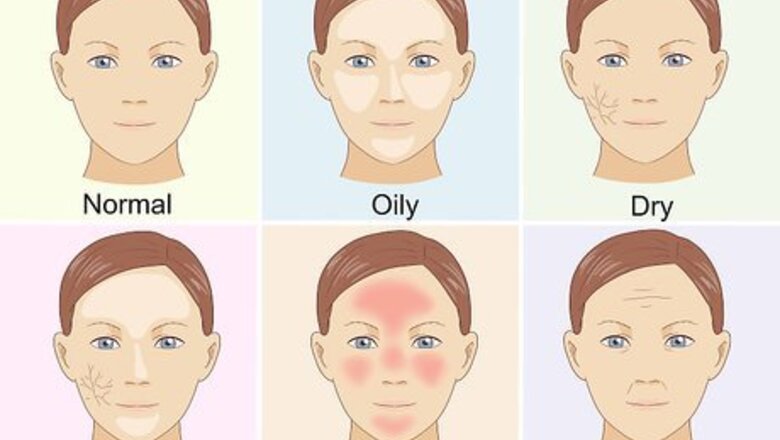
views
Picking Products for Your Skin Type
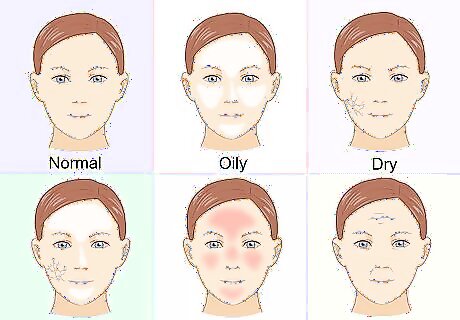
Figure out your skin type. Wash your face and pat it dry, then wait for an hour. Press a clean tissue to your nose, chin, cheeks, and forehead, and then look to see if there’s an oil residue on the tissue. This can help you decide if you have oily, dry, or normal skin. If there’s no oily residue on the tissue and your skin doesn’t feel tight or dry, you have normal skin. If there is oily residue on the tissue, you have oily skin. You may also be prone to acne. If there’s no oily residue on the tissue but your skin is tight and flaky, you have dry skin. Combination skin means that your skin can be dry and oily. It might be flaky and rough around the edges, but oily along the T-zone (forehead, nose, and chin). Combination skin tends to have visible pores only in the T-zone area. If you have sensitive skin, your skin might get red and irritated very easily. If you can see fine lines or wrinkles in your skin, you have aging skin.
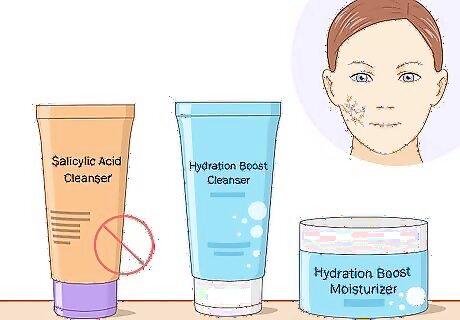
Choose moisturizing products if you have dry skin. If your skin feels tight, dry, or is flaky, you probably have dry skin. Try to avoid products that dry your skin out, like salicylic acid, and go for heavy moisturizers and hydration-boosting products. If you have really dry skin, like chapped cheeks or lips in the winter, try a thick ointment, like petroleum jelly.
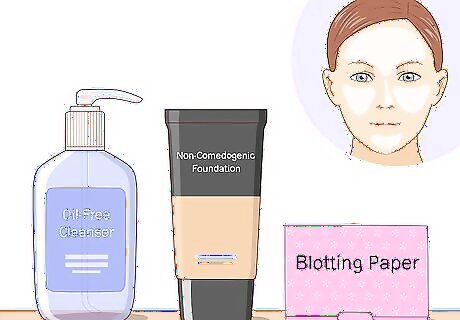
Stay away from oil-based products if you have oily skin. Having oily skin means your face produces a surplus of oil throughout the day. While it’s still important to moisturize your face, you should stay away from cleansers and makeup removers that have more oil in them so you don’t overload your skin. Go for products that say “oil-free” or “noncomedogenic.” If you’re struggling with your oily skin, try using blotting paper throughout the day to gently remove some of the oil from your face. Blotting paper is a thin, tissue-paper like sheet that collects oil gently (and you can even use it on top of makeup).
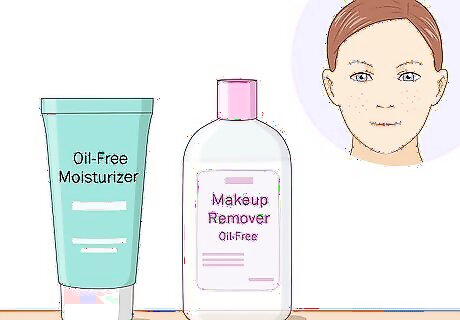
Stick to gentle, light products if you are acne-prone. Similar to oily skin, acne-prone skincare is all about staying away from heavy products that might clog your pores. Look for ones that say “oil-free” or “won’t clog pores” as you search for cleansers, moisturizers, and makeup remover products. Some products that treat acne can be drying, so make sure you keep a good moisturizer on hand to use every day.
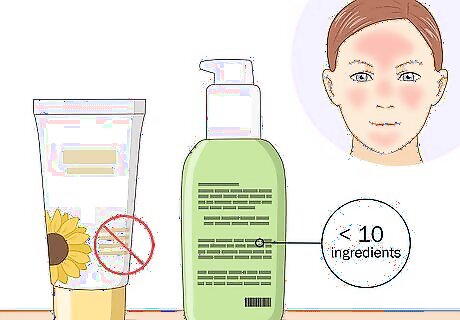
Go for products with less than 10 ingredients if you have sensitive skin. Sensitive skin needs a little bit of special treatment so you don’t irritate it. As you look for products, try to find ones that have less than 10 ingredients on the back of the bottle to ensure that you aren’t going to make your skin itchy or dry. Fragrances are often very irritating for sensitive skin. Above all else, pick products that don’t smell like anything. If you’re worried about how your skin might react to a new product, try testing it on a small patch of your face or neck for 24 hours before you use it all over. If you have any redness or itching in that spot, don’t use the product.
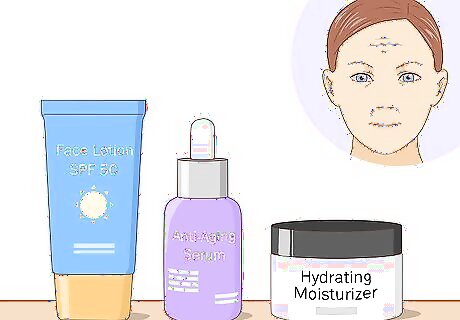
Pick products that are moisturizing and hydrating if your skin is aging. As you get older, your skin may start to wrinkle and not be as elastic. While this is totally normal, adding some hydration to your skin can help slow down the process and brighten up your face. Stick to products that are moisturizing and lock in hydration if you have aging skin. You should also pick products that have SPF in them, as aging skin is very prone to sun damage. Look for products that say “anti-aging” on them, but be wary of unrealistic promises (look 10 years younger in 1 week!).
Developing a Skincare Routine
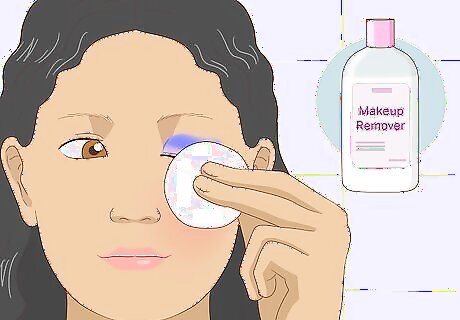
Remove your makeup with makeup remover if you wear it. Before bed or after exercising, use a makeup wipe or a liquid makeup remover to clean your face. Gently wipe the makeup remover over your face, focusing on the areas where you are wearing makeup. Wipe off your face in a circular motion until the wipe comes away clear, then move onto the rest of your skincare routine. You can use oil-free makeup remover, micellar water, or makeup wipes to take off your makeup. If makeup is left on the skin overnight it can clog the pores, while also denying skin the opportunity to repair itself from the stresses of the day. This opens the door to blackheads, breakouts, excess oil, and all manner of undesirable issues!
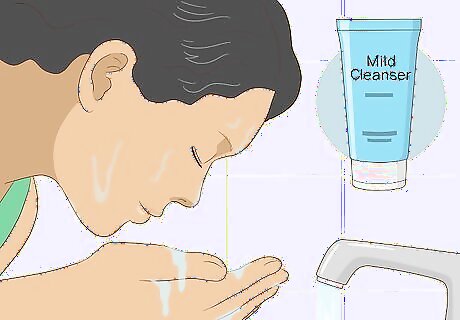
Wash your face with a mild cleanser twice a day. Wet your skin with lukewarm water from the sink and dab your face cleanser onto your hands. Lather it in between your palms, then rub the cleanser into your skin. Rinse it off completely with water, then pat your skin dry with a clean towel. Hot water can open up your pores and irritate your skin, while cold water can close your pores and trap dirt and grime. Go for lukewarm water for a soothing cleanse. Pin your hair back before you begin washing to ensure that you have access to all the edges of your face. Foam cleanser is great for digging in deep to unclog your pores. Oil cleanser is nice for dissolving traces of makeup, but it can clog your skin if you’re prone to acne.
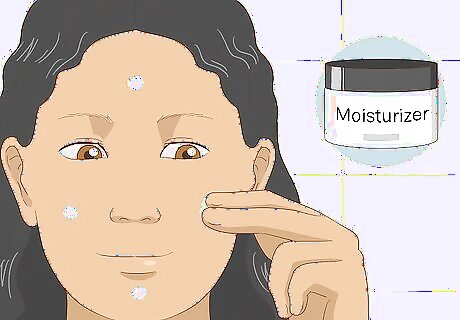
Apply a quarter-sized drop of moisturizer to lock in hydration. Squirt a quarter-sized drop of moisturizer onto your fingertips, then rub it around your hands to spread it around. Rub the moisturizer into your skin, focusing on the areas that are the most dry, like your forehead, chin, and cheeks. Let the moisturizer soak in for about 5 minutes before you move on. If you have “normal” skin, meaning not dry or oily, opt for a water-based moisturizer. If you have dry skin, go for a hydrating, oil-based moisturizer. If your skin is oily or prone to blemishes, go for a lightweight, water-based moisturizer. Aging skin tends to dry out easily, so look for a richer, oil or petroleum based moisturizer.
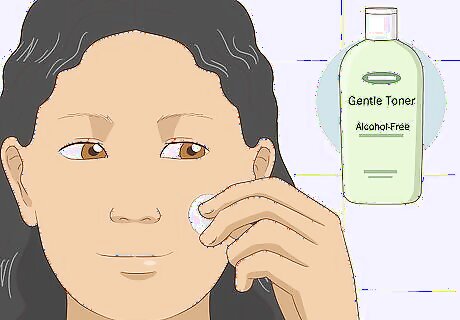
Replenish your skin with a gentle toner. While toner isn’t an absolute necessity in your skin care routine, it can help to close your pores and rebalance your skin’s pH. Squeeze out a pea-sized drop of a gentle, alcohol-free toner, then rub it into your skin to even out your skin tone and lock in hydration. Stay away from toner that has alcohol in it, especially if you have dry or sensitive skin, as it can be irritating. Witch hazel can also be a skin irritant, so steer clear of toner with that ingredient as well.
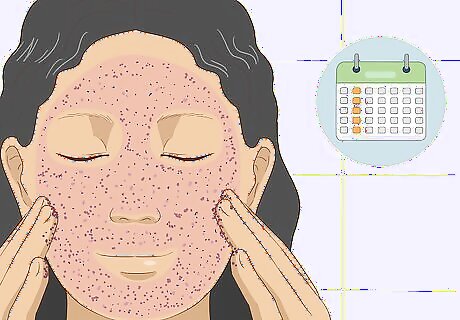
Exfoliate once a week to remove dead skin cells. This can be done with a physical or a chemical exfoliant. Get your face wet, then squirt a dime-sized amount of an exfoliating product into your hands and rub it around your finger tips. Gently rub the exfoliating product into your skin in a circular motion, focusing on any areas that are dry or oily, and especially avoiding the under-eye area. Rinse your face off well with water and then pat your skin dry. Physical exfoliants usually come in the form of a scrub and have small, rough particles in them to slough off dead skin and rejuvenate your skin. However, many dermatologists consider this form of exfoliation to be overly harsh on the skin. If you wish to pursue this method, be sure to only do it once a week—doing it too often can lead to redness and irritation, especially if you have sensitive skin. If you have very dry skin, talk to your dermatologist about chemical exfoliators. While chemical exfoliation sounds harsher, it is actually the least irritating form of exfoliation and is ideal for all skin types. Look for products with alpha-hydroxy acids (AHAs) like glycolic, lactic, or mandelic acid. Exfoliation is very drying, so be sure to follow up with a moisturizer.
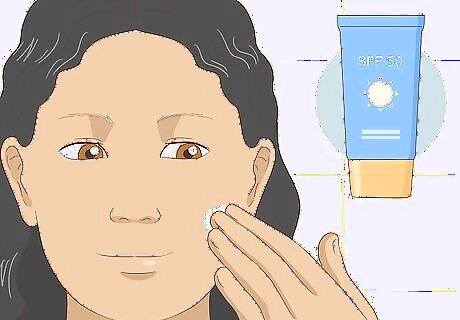
Apply sunscreen every day to protect your skin. Look for a sunscreen that’s at least SPF 30 and rub it into your skin as your final step. The sunscreen will protect you from the sun’s harsh rays to avoid redness, dryness, and wrinkles over time, and you should wear it every day, even if you’re just staying inside. Remember to wear sunscreen every time you go outside, even in the winter. Just because it’s not sunny out doesn’t mean you can’t still feel the effects of the sun.
Troubleshooting Skin Issues
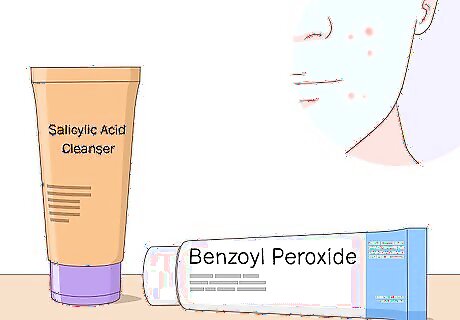
Fight acne with products that dry your skin. Try using cleansers containing ingredients such as triclosan, benzoyl peroxide, and salicylic acid. Use a lightweight, oil-free moisturizer to combat any dryness that the products may cause, and talk to a dermatologist if your acne sticks around. Acne is a totally normal problem that almost everyone goes through, especially teens and young adults. In addition to the normal skincare routine, it often helps to use a medicated spot treatment, which usually comes in cream or ointment form. Some of the most effective treatments contain ingredients such as benzoyl peroxide, salicylic acid, sulfur, retinoids, and azelaic acid. Although most of these topical treatment creams are available over-the-counter, some stronger concentrations may require a prescription. Try not to touch or pop your pimples, as that can make them bigger or make them scar.
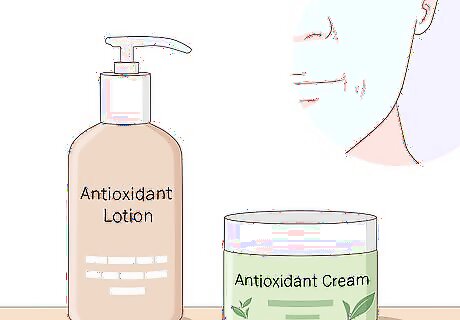
Combat wrinkles with products that have antioxidants. Look for moisturizing creams or lotions containing antioxidants. Antioxidants neutralize free radicals that destroy skin cells and contribute to signs of aging. Some common ingredients that contain antioxidants include tea extracts, retinol (a vitamin A compound), and kinetin (a plant compound that is believed to increase collagen in the skin). Wrinkles are a normal part of getting older, and they aren’t a bad thing. Don’t feel like you have to cover up a totally normal part of aging! You can also talk to a dermatologist about treating wrinkles with retinoic acid, a form of vitamin A that’s only available by prescription.
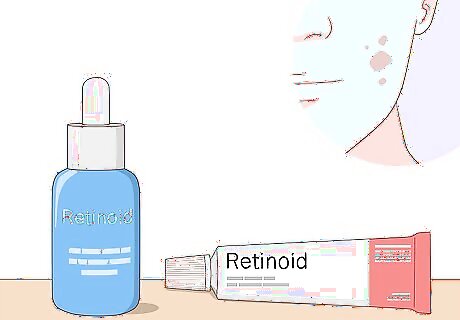
Even out discoloration with retinoid products. Pick up a selection of skincare products containing retinoids and use them on a daily basis. Retinoids exfoliate the skin to remove the discolored top layers of skin and replace them with fresh, new skin, leading to a brighter, more even skin tone. Dark spots on your skin can be caused by a number of things, like sun exposure, pregnancy, menopause, medications, or blemishes. If you’re using retinol products, you should notice a difference in your skin within a few months. The best way to prevent dark spots on your skin is to wear sunscreen.
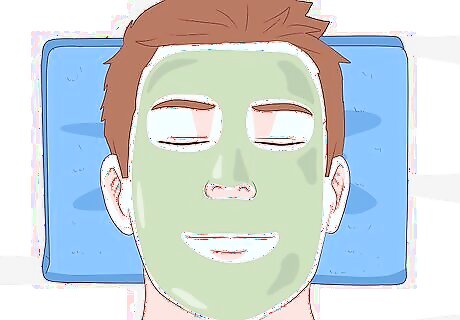
Use a face mask to moisturize and hydrate your skin. Face masks are thick creams or sheets that you can apply to your face and let them dry to moisturizer, hydrate, and brighten your skin. You can pick one that’s made for your skin type to make sure you’re getting the most benefits, and try to use one about once a week to avoid overwhelming your skin. You can make your own face mask or purchase one from the store.
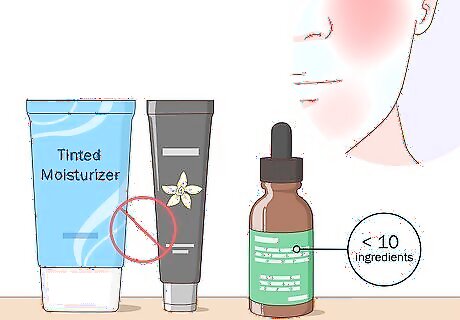
Be gentle with your skin if it’s sensitive. When buying products for sensitive skin it is important to avoid cleansers, moisturizers, and other products that contain colors or fragrances. Those ingredients are much more likely to irritate your skin or give you an allergic reaction. When choosing, try to go for the simplest products possible—look for cleansers and creams with 10 ingredients or less. Sensitive skin can mean a lot of things, but the best way to know you have sensitive skin is if your skin gets red or irritated after using products or makeup. Look for products that contain soothing and anti-inflammatory ingredients such as chamomile, white tea, aloe, calendula, oats, and marine plants.
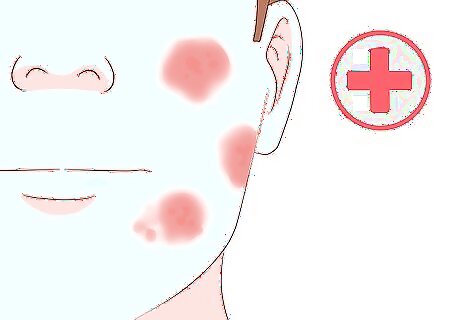
See a dermatologist for serious skin issues. If you have reoccurring acne, psoriasis (itchy, dry patches of skin), rosacea (redness or pus-filled bumps), or deep scars, you may need to talk to a skincare professional about treatment. Make an appointment with a dermatologist to talk about your next steps. Dermatologists can prescribe you prescription-strength creams, lotions, and ointments to help clear up your skin.
Making Lifestyle Changes

Follow a balanced diet with lots of vitamins. Incorporate fruits and vegetables, whole grains, lean protein, and healthy fats into your diet to keep your body and skin healthy. Your overall health can affect the appearance of your skin, so it’s important to factor in your entire body when going for clear, beautiful skin. You can also try supplements made specifically for hair and skin that contain vitamin B and vitamin K.
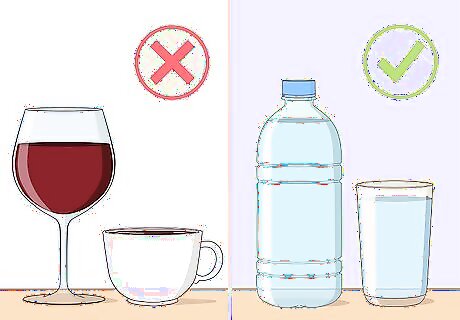
Drink about 8 glasses of water per day to stay hydrated. Although staying hydrated and clear skin don’t have a direct correlation, drinking water is an important part of keeping your body healthy overall. Carry a water bottle with you and try to drink from it every time you’re thirsty to stay hydrated throughout the day. Try to avoid dehydrating liquids, like coffee or alcohol.

Get at least 8 hours of sleep so your skin looks rested. When you don’t get enough sleep, you may wake up with dark circles under your eyes and tired-looking skin. Try to stick to a regular sleep schedule and aim for about 8 hours every night to let your skin replenish and repair itself while you snooze. If you’re a teenager, aim for 9 to 10 hours of sleep per night. Getting enough sleep will also lead to better overall health.

Lower your stress levels to avoid exacerbating your skin issues. Stress is bad for your skin on every level. It can contribute to excess oil, breakouts, redness, sensitivity, and wrinkles. Try to incorporate some stress-reducing activities into your weekly routine, like yoga, meditation, painting, reading, or drawing. Stress reduction looks different for everyone, so you may need to try out a few different methods until you find the right one for you.
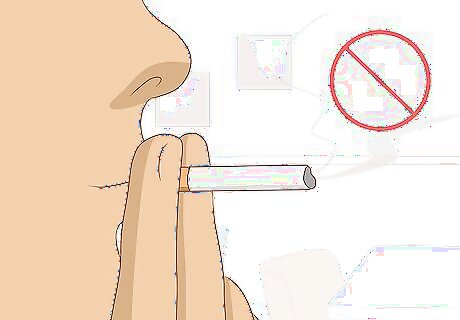
Stop smoking, if you can. Smoking cigarettes can lead to skin discoloration and wrinkles, and it can make your skin look much older than it actually is. If you feel up to it, try to stop smoking cigarettes as soon as you can for healthier, brighter-looking skin. Giving up smoking is not the easiest thing in the world, but with some determination and support from your friends and family it is possible. You can try nicotine patches and nicotine gum to help wean yourself off of cigarettes.














Comments
0 comment